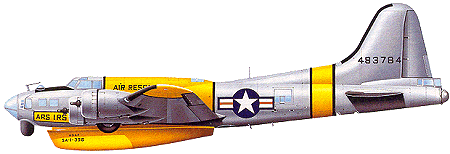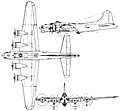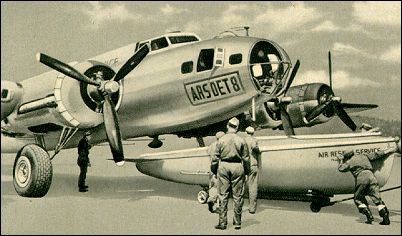|
| Frustrated in their efforts to acquire a fleet of strategic bombers for service with the Army Air Corps, US Army planners - who were devotees of the theories expounded by Brig Gen William 'Billy' Mitchell - inserted the thin end of an important wedge when they ordered a small number of YB-17 prototypes in January 1936, ostensibly for the nation's defence. Originating as the Boeing Model 299, the prototype was built as a private venture, Boeing gambling heavily on producing a winner that would bring a large military contract. It must have seemed to Boeing that their gamble had failed when, almost at the end of the military trials, the Model 299 crashed on take-off. Fortunately investigation proved that the aircraft had been flown off with the flying controls locked and safety of the basic design was not suspect.
It was not until 1938 that the USAAC was able to place an order for 39 production B-17B, the last of this batch entering service in March 1940. These were the first B-17 production aircraft to be equipped with turbocharged engines, providing a higher maximum speed and much increased service ceiling. Of the B-17C which followed, a batch of 20 were supplied to the RAF (designated Fortress I) and used operationally in Europe for evaluation, leading to improved B-17D and B-17E aircraft with self-sealing fuel tanks and revised armour and armament.
The B-17E was truly a flying fortress, armed with one 7.62mm and 12 12.7mm machine-guns for defence and able to carry a maximum 7,983kg of bombs. Most extensively built variant was the B-17G (8,680), being built by Douglas and Lockheed Vega as well as at the Boeing plant, Seattle. Pratt & Whitney R-1820-97 radial engines and improved turbochargers enabled the B-17G to operate at an altitude of up to 10,670m; and the addition of a chin turret below the nose (containing two 12.7mm machine-guns) provided better defence against the head-on attacks being launched by Luftwaffe fighter pilots in their attempts to reduce the numbers of Fortresses striking daily at strategic targets deep in German territory.
Special variants included the B-40 with up to 30 machine-guns/cannons, which was intended as a B-17 escort, but proved to be an operational failure; BQ-7 pilotless aircraft packed with explosives to be deployed against German targets by radio control, which failed due to unreliable control equipment; CB-17 and C-108 transports; and F-9 long-range B-17 equipped to serve as an air-sea rescue aircraft and able to deploy a lifeboat carried beneath the fuselage.
In Britain, more than anywhere else in the world, the B-17 evokes vivid memories of courageous aircrew who day after day - despite sometimes horrific losses - continued to attack targets in Europe until victory was won. For Boeing, their private-venture gamble paid off: a total of 12,731 Fortresses were built by the Boeing, Douglas and Lockheed team.

| CREW | 11 |
| ENGINE | 4 x Wright-Cycl. GR-1820-97, 885kW |
| WEIGHTS |
| Take-off weight | 32720 kg | 72136 lb |
| Empty weight | 24900 kg | 54895 lb |
| DIMENSIONS |
| Wingspan | 31.6 m | 104 ft 8 in |
| Length | 22.7 m | 75 ft 6 in |
| Height | 5.8 m | 19 ft 0 in |
| Wing area | 141.9 m2 | 1527.40 sq ft |
| PERFORMANCE |
| Max. speed | 438 km/h | 272 mph |
| Cruise speed | 250 km/h | 155 mph |
| Ceiling | 10700 m | 35100 ft |
| Range | 2980 km | 1852 miles |
| ARMAMENT | 13 x 12.7mm machine-guns, 8000kg of bombs |
 | A three-view drawing (1000 x 927) |
| PHILLIP WOODS, e-mail, 01.09.2010 01:54 SEVERAL YEARS AGO I MET A FORMER BALL TURRET GUNNER FROM THE 91ST GROUP. HIS NAME WAS "JUNIOR" VIDMAR.i tALKED TO HIM OVER DINNER ONE EVENING IN THE 1980'S THRU HIS DAUGHTER WHOM I WAS ACQUAINTED WITH. THE NAME ON HIS B-17 WAS "LADY LUCK". PILOTS NAME WAS "WITZENFELD" I BELIEVE. ANYWAY, HE HAD SOME INTERESTING STORIES. SAID HIS LAST MISSION WAS TO SCHWEINFURT. WOULD LOVE TO HEAR FROM ANYONE WITH RELEVANT INFO.I HAVE ALWAYS BEEN A B-17 FAN AND HAD THE PRIVILEGE TO FLY ON ONE SEVERAL YEARS AGO- EXPERIENCE OF A LIFETIME! reply | | Richard, e-mail, 19.03.2010 05:46 To all,
I would like to fly the Swamp Fire around the world. I have Google Analytics recording all the hits from all the different countries. I ask you to visit the site and send the address to your friends and then have then do the same Etc, Etc, Etc. I think it would be interesting to see the results and see how fast and how far this will go.
sites.google.com /site /swampfiresite /home
Thanks
Richard reply | | Gary Lesters, e-mail, 11.03.2010 23:51 As a radio operator on a B-17G, we dubbed Pacific Tramp 2, it was the biggest plane in the air at the time. I never thought they would ever get any bigger. Obviously I wasn't able to foresee the future but not too long after we landed in the Pacific along came the B29. Our beautiful 17 was outsized. However, she was our baby & I painted gorgeous Esquire girls on the nose to prove it. Our crew headed up by James Gordon Pugh of California was an 18 year old pilot entrusted with a million dollar plane & 9 human lives, some of whom were older than he was but none with his abilities which were outstanding. I have many times tried to find him to no avail. In our converted 17 we were fitted for our job as an air /sea rescue team with an 0wens unsinkable twin engine boat capable of carrying 15 people with enough food & supplies for 15 days, able to convert sea water to drinkable, SOS radio,inflatable cover and many other features. It was a remarkable plane & crew. I often think of them. reply | | Thomas s, e-mail, 06.03.2010 12:46 My dad flew 33 successful missions in one during WW11 and got shot down twice i beleive it was a b17 i am not sure reply | |
| | Roy Bittner, e-mail, 26.02.2010 02:20 In 1950 I was at Kindley AFB Burmuda Flidht D 1st Rescue Sqd. We had 3 of the B-17 with the drop Boats under the bellies. They had no trouble getting off the ground or landing with them. They did a lot of escourt duty for planes with minor trouble comeing home from europe. reply | | Alan Brush, e-mail, 24.02.2010 18:15 My father, Melvin Brush, served with the 305th BG out of Chelveston, England. While he was alive he participated in the reunions that they BG group had. I was lucky enough to go with him to one of them help in Seattle Washington. Mel passed away almost 6 1 /2 years ago and would love to get ahold of any of his old commrades who remember him and served at Chelveston during the war.
Alan Brush reply | | George League, e-mail, 04.09.2010 06:06 In response to B.O.B's note about the sinking of the Bismark, the USS New Jersey had nothing to do with that. The Bismark's rudder was jammed by a torpedo from planes from the Ark Royal, and later sunk by gunfire from the ships King George V, Rodney, Norfolk, and Dorsetshire. reply | | Richard Lewis, e-mail, 06.02.2010 04:41 Excuse me for the mistake on the previous post. The Swamp Fire website is located at:
sites.google.com /site /swampfiresite /home reply | | Richard Lewis, e-mail, 06.02.2010 04:35 I am trying to locate former Ground and Air Combat Crewmen of the 379th BG. We are also looking for the families of former airmen who might have been on the Swamp Fire 42-32024. If you are unsure you can search our site under the Crews and Missions section to see if you recognize any of the names:
ttp: / /sites.google.com /site /swampfiresite /home
If you know of or recognize any of these airmen please contact us. reply | | B.O.B, 05.09.2010 08:42 Yes George I know I was being sarcastic, but why did'nt you say some thing about the US 8th airforce in 1940? reply | | George Roberts, e-mail, 30.01.2010 00:11 For its time in history, this was the best plane ever.I was the radio operator gunner for 31 missions in a B17 and it kept on flying despite many savage hits by fighters and flak. My last 15 missions were on B17 42-102547 (Rose of York)which was christened by the present Queen of England on July 6, 1944 reply | | Carol Rose Offutt, e-mail, 27.01.2010 15:17 My father flew 54 missions as pilot of the B-17 in Europe with the 92nd BG. His story is For This Marvelous Country.
www.forthismarvelouscountry.com reply | | Dr. Jack Goldstein, e-mail, 24.01.2010 21:44 Flew 25 missions in the 8th AF, 381st Bomb Group, 535 Pomb Squadron. Was Waist gunner and Toggelier (substitue Bombardier) Always counted on the 17 to bring me back to Ridgewell, Enland. reply | | B. Clark, e-mail, 10.01.2010 18:12 check out sites.google.com /site /swampfiresite /
for the skinny on one of the most famous B-17s of the 8th Air Force. I was copilot reply | |
| | bob brophy, e-mail, 05.01.2010 05:47 great plane for photo work. stood up good under crash conditions to.... reply | | Bill Varnedoe, e-mail, 03.01.2010 01:55 I was navigator on the Crow crew, 550SQ, 385BG.
I am the Historian of the 385th Bomb Group Association.
That 13th gun in the radio hatch was removed, as it did not do any good (other than making movies of gunners in combat.) Besides, the radio operator manned a waist gun over enemy territory after the crew was reduced to 9 men!! reply | | dude, 21.09.2009 13:19 Bombs away ! dudes, relax man! reply | | Edward P Gilmore, e-mail, 26.04.2009 18:24 I was on a crew of an air sea rescue B17 in 1945 stationed in Abadan Iran. The plane still had the ball turret behind the boat. Can you tell me where I can get a model of this plane? reply | | Gary McFall, e-mail, 23.12.2008 23:37 I'm building afull scale B-17 instrument panel. I have almost all instruments now , but what I need are dim drawings of the 3 panels. Can anyone help?
Thanks
Gary reply | | Tom, e-mail, 03.11.2008 22:02 Hello, can someone tell me what plane was used as a primary bomber in USA before the Boeing 17 production? reply |
|
Do you have any comments?
|
| 
COMPANY
PROFILE
All the World's Rotorcraft
|








